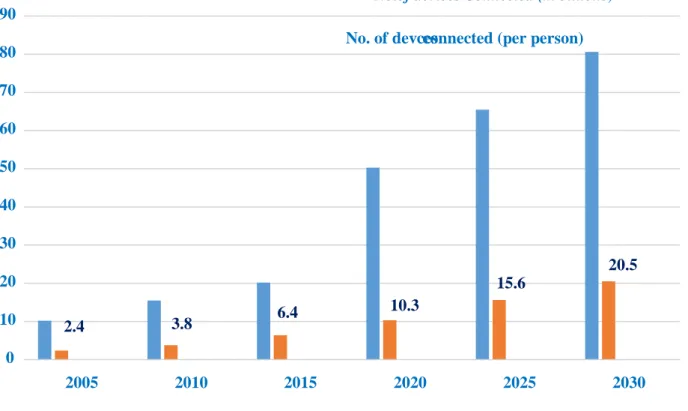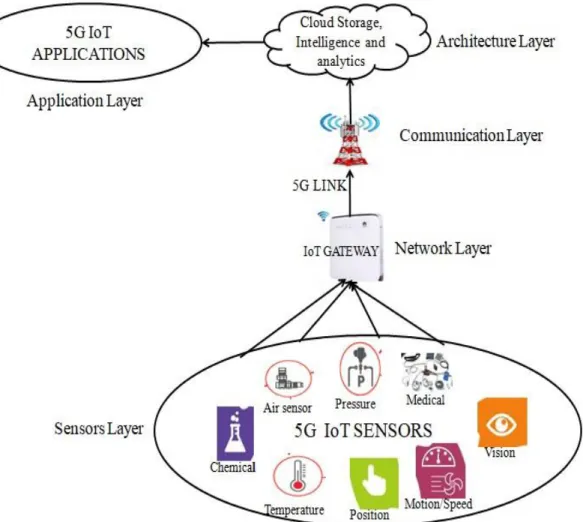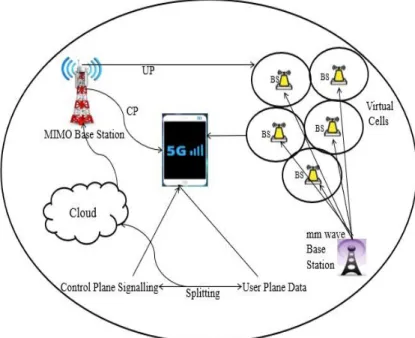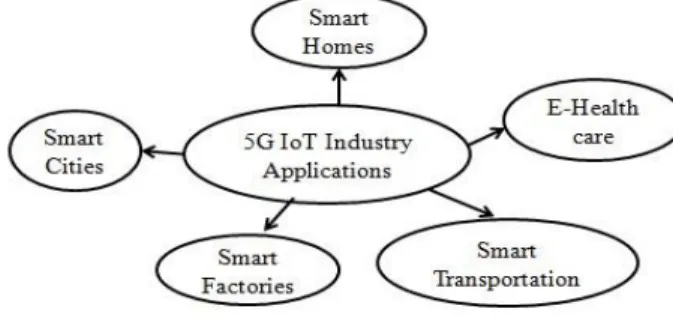I hereby certify that the thesis entitled "Study of Internet of Things (IOT) with 5G Wireless System" was completed under my direct supervision by the following students and that this work was carried out in the laboratories of the Department of Electrical and Electronic Engineering at the Faculty of Engineering, Daffodil International University in partial fulfillment of the requirements for the Bachelor of Electrical and Electronics Engineering degree. Thesis entitled “Study of Internet of Things (IOT) with 5G Wireless System” submitted by Md Shakil Hossain ID No Session: Fall 2017 has been accepted as satisfactory in partial fulfillment of the requirements for the degree of Bachelor of Science in Electrical and Electronics engineering on June 27, 2021. List of Figures viii List of Tables viii List of Abbreviations Ix-x Acknowledgments xi Abstract xii.
ACKNOWLEDGEMENT
ABSTRACT
INTRODUCTION
- INTRODUCTION
- Problem statement of IOT 5G
- Objectives
- Research Methodology
- Thesis Outline
Nowadays, wireless communication with high-speed net property and better information rates has a great demand for the society and the necessary measure think about good economic development and conversion of the society and also the world. 5G wireless technologies in IoT square peers are expected to use the unauthorized or unused spectrum band and it will only be accessed by low power wide area networks (LPWAN) such as SigFox, LoRa, WiFi, ZigBee and NB-IoT [1]. The technology associated with NR square measures psychological feature wherever standalone mode for spectrum usage is employed, in band for correct spectrum utilization and waiting band for utilization of unused resource block.
Today, current mobile phone users are measured in the millions with an annual growth rate of about twenty-five and are expected to reach eighty billion by 2030. This relatively good technology provides a huge demand for a future communication system that can be fast and with many connected devices this square measure, which is usually supported in combined networks called "heterogeneous network" (HetNets). A key motivation for the development of the Internet of Things is expected through 5G cellular networks, and a large variety of devices per square that require key information speeds are expected to be introduced [1].
CHALLENGES AND VISION OF 5G IOT
Introduction
Some analytics companies with world-class laboratory facilities are engaged in 5G analysis and experimentation.
Vision of 5G IoT: Industrial and Research Perspective
Intel is working on the latest technologies, such as Licensed Access (LAA), which can increase speed. According to Industry 4.0, Intel is working on IoT products and technology in robots and robotics. They have developed Network as a Service (NaaS) slicing on IoT cloud computing in 5G networks as the best telecommunication services.
They have successfully completed the integration of NB-IoT chips, such as smart energy monitoring through NB-IoT devices. Ericsson has a major contribution to 5G smart factories and smart healthcare through the development of smart devices and sensors. Nokia expects its 5G footprint in mid-2019 and is currently partnering in the 5G domain with airtel and BSNL.
They have made major contributions in RAN and MIMO antenna technology such as adaptive array and beamforming. They are working on several important opportunities to increase the energy efficiency of the base station: some of them are as follows. Nokia is working on MIMO and mm-wave technologies and has demonstrated 5G deployment below 6GHz, resulting in ubiquitous coverage, especially for massive IoT and critical communications.
They are also working on reducing latency in 5G communications through successful NR numerology selection and mini slots. They also contribute to cloud services such as virtualized core network functions in the cloud. IoT can be used in various areas of life-changing applications such as smart factories, smart hospitals, smart transportation, smart agriculture, smart homes and cities etc.[3][4].
IoT in vehicle communications can be used in situations prone to collisions and accidents through the transfer of information between cars and street lights via radars and sensors.

2.3 : Motivation and Objectives
ARCHITECTURE OF 5G IOT WITH USER APPLICATIONS
- Introduction
- Sensors Layer
- Network Layer
- SigFox
- LoRa
- ZigBee
- Narrowband Internet of Things (NB-IoT)
- Summary of LPWAN Used in 5G IoT
- Communication Layer
- Waveform, Numerology and Frame Structure
- MIMO and mm wave radio frequency technology for future 5G heterogeneous networks
- Architecture Layer
- Infrastructure as a Service (IaaS)
- Platform as a Service (Paas)
- software system as Service (SaaS)
- Application Layer
It is a coffee energy-wide space network used for IoT communications. it is an extended associate degree version of IEEE.802.15.4 with all OSI layers. Using ZigBee in IoT technology has had several advantages over alternative networks, as it is simpler and cheaper. The modulation theme used in 5G will be the main issue responsible for the performance of the 5G system. PAPR, spectral potential and interference area are the main issues to consider in 5G NR.
In 5G NR square measure, a subject area of study bailiwick branch of knowledge} resource components are sorted into physical resource block (PRB) wherever each PRB includes twelve subcarriers achieved for a hundred and twenty rate. Transmission of enormous data with no interference, higher power and secure communication are the most important needs in 5G IoT and this can be achieved by increasing the amount of antenna arrays in MIMO configuration. The main reason for abusing millimeter wave frequency in 5G is that it offers an enormous chance to abuse unused spectrum bands through economic sensing compared to lower frequencies.
Therefore, it is proposed to use higher frequency zero in millimeter wave communication technology in 5G NR. Cloud-based, usually RAN (CRAN), considers a split between user and management planes, providing flexibility and potential in 5G mobile networks. The HetNets in 5G is used to expand information measurement, transmission power, and guarantee the standard of service (QoS) to the users.
Therefore, millimeter wave communication technology is taken into account as it is the key technology to prepare HetNets in 5G IoT. In 5G IoT, cloud-based design is the most popular because cloud technology is the most trending technology in IoT and is mainly associated with information technology (IT) services and can be extended to embedded system programming. Since then, IoT exists with enormous information and is managed through the cloud. It is an online based computer where services such as servers, information storage, login, registration interface, authentication and application are provided through cloud web. Normally, there are three basic models of cloud computing and square measures mentioned below.
This model accounts for non-core functions such as application infrastructure support, scale back maintenance and reduction of employee needs. it is responsible for containing deployed application; compile settings for the host environment. This cloud preparation during this state quadratic measures created, controlled and death of the company. it is implemented in a single tenant atmosphere and not united with alternative clients. It reduces restrictive issues. it is very expensive than sharing public cloud, but has a lot of financial and system compared to public cloud.

Research Gaps and Future Direction with Cyber Security
- Introduction
- Big Data Aided Network Framework
- New Waveform design consideration for 5G New Radio (NR)
- Energy Efficiency
- Trade-off among communication, catching and computing
- Design of concurrent multiband and high-power efficiency Amplifier
- CYBER SECURITY AND PRIVACY IN IOT ENVIRONMENT
These limitations of OFDM are mainly based on wave area units, as the analysis challenge for 5G waveforms. Deployment- Energy trade-off: it is used to win a low price and less energy consumption within the network. In context of 5G IoT, capture and machine resources should be used to show intelligence to support massive information application in heterogeneous networks.
Thus, the trade-off in the 5G network between the HetNets resources is necessary for optimal resource provision. Because 5G IoT is developing with a huge amount of information and this information area unit is collected from completely different sources, resulting in non-uniform distribution of information burden. It is important to incorporate the multiband power electronics into 5G IoT to reduce the value and physical size of the ground station.
Multiband power electronic equipment will support signals of multiband frequency simultaneously; it allows all wireless functions to perform all at once. The economical power electronic equipment in the base station plays an important role in the evolution of mobile systems. Cyber Attacks Area Unit has been around since eighties and hence the attacks have been labeled as 'General Attacks'.
Some of the necessary principles of cyber security measures area unit: confidentiality and integrity: it is the competence to cover necessary information between user and recovery provider World Health Organization is unauthorized user. Some necessary information such as personal information, security keys, trades and military information, server information, etc. should be properly and confidentially hidden from hackers and attackers. Authenticity: only licensed user should get information to perform the operation within the networks.
PLCs and SCADA are the main promising technology in IoT for secure and preventive protection.
ADVANTAGE &COMPARISON OF 5G
Introduction
Advantage of 5G Network
Comparison with 1G to 5G
It was a serious leap in technology when wireless networks went from analog to digital. The terrible first generation of mobile networks for businesses was introduced in the late 70s with absolutely enforced standards established through the 80s. These square measure the analog telecommunications standards that were introduced in the 1980s and continued until they were replaced by 2G digital telecommunications.
The advancement of technology from 1G to 2G introduced several basic services that we still use these days, such as SMS, internal roaming, conference calls, supported decision retention and billing services, e.g. This generation set the standards for many wireless technologies that we understand and love. This network combines aspects of the 2G network with some new technology and protocols to deliver much faster speeds.
3G increased the power of the frequency spectrum by increasing, however audio is compressed during a decision, so many calls coincide within the same frequency vary. A 3G phone cannot communicate over a 4G network, however newer generations of phones are constantly being designed to be backwards compatible, so a 4G phone will communicate over a 3G or possibly 2G network. 4G can be an awfully completely different technology compared to 3G and was created very potential just because of the advancements within the technology within the last ten years.
4G is not an equivalent of 4G LTE that comes very close to meeting the factors of the standards. Newer generations of phones are typically designed to be backwards compatible, meaning a 4G phone communicates over a 3G or perhaps 2G network. There is a large amount of infrastructure changes that need to be enforced by service providers to be able to produce as a result of voice calls in GSM, UMTS and CDMA2000 are circuit switched, so with the adoption of LTE, providers can redesign their network for voice decisions.
Next Generation Mobile Networks Alliance feels that 5G must be expanded by 2020 to meet business and customer needs.
CONCLUSION AND FUTURE RESEARCH SCOPE
Conclusion
FUTURE RESEARCH SCOPE OF IOT 5G NETWORKS

